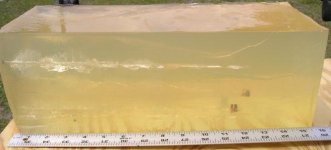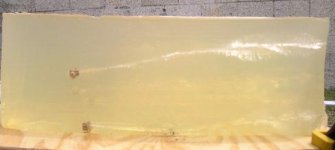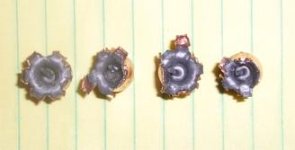Hello. I am posting here the results of a few tests that I conducted last summer because the results are posted on other websites and not on this one. Really I just wanted to the share the information with you, because when my gelatin powder runs out (~ 3 weeks), that will be the end of the line for me, as far as ballistic gelatin testing is concerned. :
"
TEST ONE
.380ACP Federal Personal Defense (90 gr. Hydrashok)
Calibration = 3.1875" velocity = 582 ft./s.
Shot 1 - Penetrated 12.5"
Shot 2 - Exited block at 11.9375"
Shot 3 - Penetrated 12.4375"
Shot 4 - Penetrated 11.9375"
Shot 5 - Penetrated 12.0625"
Average impact velocity = 843 ft./s.
Average recovered diameter = 0.469"
Firearm = Kel-Tec P3AT
TEST TWO
Hello. I tested 5 rounds of .380ACP Federal Personal Defense from a P3AT in Ballistic Gelatin last weekend.
The gelatin was Vyse brand, mixed at 10% concentration into an FBI sized block (6x6x16)". Calibration BB traveled at 594 fps and penetrated 9.4cm.
The front of the block was covered in 1 layer of 100% cotton, new and unwashed, fruit-of-the-loom T-shirt material. This material was chosen after reviewing several 100s of mugshot photos of violent criminals and their choice of upper body clothing. It also is representative of clothing worn most of the time in the southern US, where I live.
Average penetration was 12.0"
Average expansion was 0.476"
Average impact velocity was 839fps.
Lot number = 2 09H449
"
This test was undertaken to find an expanding load for a semiauto .380ACP with a short barrel, that would penetrate to FBI minimum penetration depth. This turned out to be a very hard thing to do, with only the Federal load making the cut. I would seriously recommend to short-barreled .380ACP owners to test your bullets in a valid medium or have them tested by someone qualified to do so.
Please look at the third pic, that of the bullets. The first one on the left was loaded by hand into the barrel, the rest were magazine fed. It is my opinion that the feed ramp on the barrel was damaging the hollowpoint, causing one side not to open up. While these subsequent bullets do penetrated satisfactorily, the expansion is just not as good as the first round. Does anyone know how to correct this on a Kel-Tec ? I.E. stop the barrel from eating up the shape of the bullet?
Thank you.
Tom
"
TEST ONE
.380ACP Federal Personal Defense (90 gr. Hydrashok)
Calibration = 3.1875" velocity = 582 ft./s.
Shot 1 - Penetrated 12.5"
Shot 2 - Exited block at 11.9375"
Shot 3 - Penetrated 12.4375"
Shot 4 - Penetrated 11.9375"
Shot 5 - Penetrated 12.0625"
Average impact velocity = 843 ft./s.
Average recovered diameter = 0.469"
Firearm = Kel-Tec P3AT
TEST TWO
Hello. I tested 5 rounds of .380ACP Federal Personal Defense from a P3AT in Ballistic Gelatin last weekend.
The gelatin was Vyse brand, mixed at 10% concentration into an FBI sized block (6x6x16)". Calibration BB traveled at 594 fps and penetrated 9.4cm.
The front of the block was covered in 1 layer of 100% cotton, new and unwashed, fruit-of-the-loom T-shirt material. This material was chosen after reviewing several 100s of mugshot photos of violent criminals and their choice of upper body clothing. It also is representative of clothing worn most of the time in the southern US, where I live.
Average penetration was 12.0"
Average expansion was 0.476"
Average impact velocity was 839fps.
Lot number = 2 09H449
"
This test was undertaken to find an expanding load for a semiauto .380ACP with a short barrel, that would penetrate to FBI minimum penetration depth. This turned out to be a very hard thing to do, with only the Federal load making the cut. I would seriously recommend to short-barreled .380ACP owners to test your bullets in a valid medium or have them tested by someone qualified to do so.
Please look at the third pic, that of the bullets. The first one on the left was loaded by hand into the barrel, the rest were magazine fed. It is my opinion that the feed ramp on the barrel was damaging the hollowpoint, causing one side not to open up. While these subsequent bullets do penetrated satisfactorily, the expansion is just not as good as the first round. Does anyone know how to correct this on a Kel-Tec ? I.E. stop the barrel from eating up the shape of the bullet?
Thank you.
Tom



